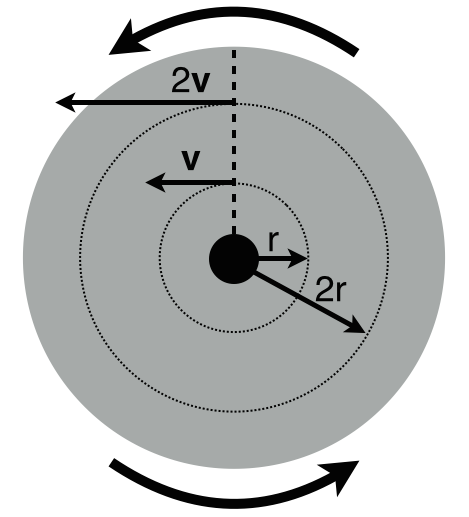Rotational Kinematics
This page is all about rotation and it's relation to torque. This page is very much a work still in progress by sthevuthasan3.
The Main Idea
Rotational motion is defined as when an object moves about an axis in a circle versus translational motion which involves the object moving in a straight trajectory.
A Mathematical Model
Rotation can be characterized by its angular velocity and angular acceleration. The equations are listed below.
Angular velocity:
- [math]\displaystyle{ \boldsymbol{{w}} = \frac{\boldsymbol{v}}{\boldsymbol{r}} }[/math] ,
where [math]\displaystyle{ {\boldsymbol{v}} }[/math] is the velocity of the object and [math]\displaystyle{ {\boldsymbol{r}} }[/math] is the radius of the circle of motion. Angular velocity always has a unit of radians (radians/sec or radians/hr).
Angular acceleration is equal to alpha:
- [math]\displaystyle{ \boldsymbol{{alpha}} = \frac{\boldsymbol{a_t}}{\boldsymbol{r}} }[/math] ,
where [math]\displaystyle{ {\boldsymbol{a_t}} }[/math] is the tangential acceleration of the object and [math]\displaystyle{ {\boldsymbol{r}} }[/math] is the radius of the circle of motion.
Examples
Be sure to show all steps in your solution and include diagrams whenever possible
Simple
A simple example and application of the concept of rotation is the earth's rotation on it's axis. It rotates once every 24 hours. What is the angular velocity?
Angular velocity can also be represented as change in angle (theta) over change in time. In this case, the earth rotates 2pi radians in 24 hours which reduces to pi/12 radians and that becomes 15 degrees.
Middling
A cylinder with a 2.5 ft radius is rotating at 120 rpm. Find the angular velocity in rad/sec and in degrees/sec. Find the linear velocity of a point on its rim in mph.
To find the solution of this problem, rpm (revolutions per minute) should be converted to radians/second. Following this, the linear velocity can be calculated by using the v=wr formula shown above. The angular velocity is 720 degrees per sec and the linear velocity is 21.42 mph.
Difficult
Connectedness
- How is this topic connected to something that you are interested in?
- How is it connected to your major?
- Is there an interesting industrial application?
History
Put this idea in historical context. Give the reader the Who, What, When, Where, and Why.
See also
Are there related topics or categories in this wiki resource for the curious reader to explore? How does this topic fit into that context?
Further reading
Books, Articles or other print media on this topic
External links
Internet resources on this topic
References
This section contains the the references you used while writing this page
